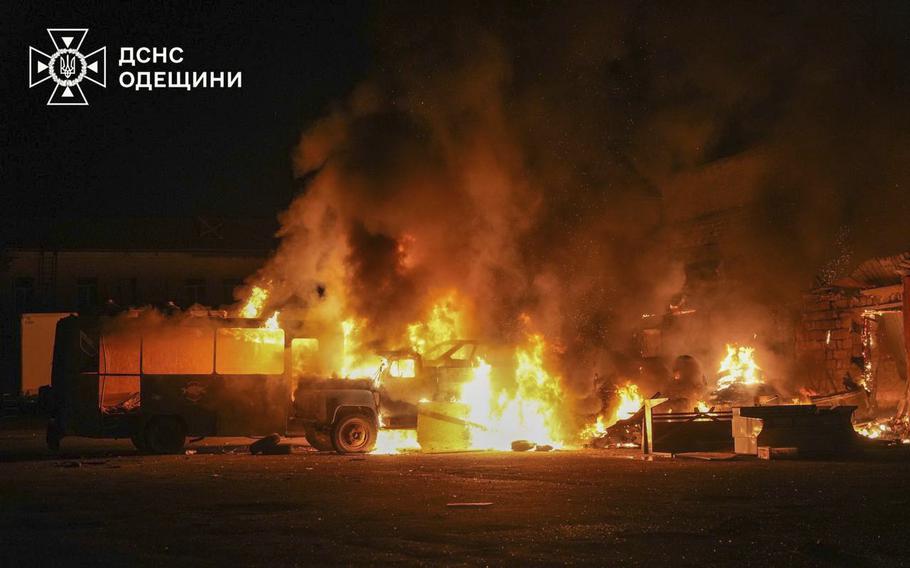
Firefighters put out a fire following a Russian attack in Odesa, Ukraine, Monday, July 7, 2025. (Ukrainian Emergency Service via AP)
KYIV, Ukraine — Ukrainian authorities are reporting a dangerous shift in Moscow’s attacks to targeting the country’s efforts to mobilize enough troops to confront Russia’s vastly superior numbers on the battlefield.
Ukraine’s cities are being hit by record numbers of missiles and drones — more than 5,000 in June alone — and the first few days of July have already seen recruitment centers come under attack five times, killing three and wounding 88, mostly civilians.
“Last week — Kryvyi Rih, two in Poltava, one in Kremenchuk. This week — Zaporizhzhia and Kharkiv. That’s a significant pattern,” said Col. Vitalii Sarantsev, spokesman for Ukraine’s Ground Forces Command. “Their goal is to disrupt the mobilization processes in our country. They are trying to sow doubt and fear among citizens, creating the image of a dangerous place - somewhere too risky to visit.”
Territorial recruitment and social support centers are responsible for registering military-age men, conducting conscription campaigns and assessing candidates for service. They also carry out physical fitness checks, medical screenings, psychological testing, recommend positions for contracted service and manage the deployment of recruits to training units.
Overnight Wednesday, Russia launched a record number of drones and rockets at Ukraine — including 728 drones — despite increasingly harsh criticism by President Donald Trump, who on Tuesday said he wasn’t happy with Russian President Vladimir Putin “because he’s killing a lot of people.”
Russia has acknowledged the new strategy targeting the recruitment centers, with lawmakers and propagandists gleefully claiming it is supported by people in Ukraine who object to the efforts to enlist new forces.
“By striking military enlistment offices, the Russian armed forces have actually made life easier for people living in Ukraine. Strangely enough, many residents of that country enthusiastically welcomed the destruction of these offices,” Russian Duma deputy Andrei Kolesnik told Lenta.ru. Russian bloggers are also claiming that locals are publicizing coordinates of the centers to attract attacks.
There is a great deal of Russian-sponsored content and propaganda on social media maintaining that Ukraine engages in highly unpopular forced recruitment of its citizens.
Facing an adversary with a population several times larger, Ukraine is under constant pressure to replenish its ranks on the battlefield. After three years of grinding war, recruitment has become increasingly challenging and many do seek to dodge the draft. Targeting the institutions responsible for mobilization further exacerbates the country’s severe personnel challenges.
While under the draft all able military-age men must sign up to fight, individual units mount publicity campaigns to attract those interested in volunteering. There has also been pressure, especially from the United States, to lower the conscription age to include men 18-25 years old.
Andriy Kovalenko, head of Ukraine’s Center for Countering Disinformation at the National Security and Defense Council, noted that systematic strikes on recruitment centers are new since the full-scale war began.
“Initially, the enemy relied on information campaigns — amplifying isolated incidents and working to discredit the mobilization process and the centers themselves,” he said. Last year, Russia shifted to sabotage: recruiting local operatives for promised payments, transferring explosives and attempting to stage bombings at the center entrances. “It was terrorism by proxy. But that too failed — mobilization continued, and Ukrainian security services successfully intercepted such plots.”
According to Kovalenko, Moscow has since turned to drone strikes against the centers, using the Iranian-style self-detonating Shaheds that Russia now manufacturers itself. “This will not stop mobilization. Most data on military-age citizens have long been digitized. Disrupting the process this way is simply impossible,” he stressed.
He added that Russia continues its information warfare to portray the attacks as supported by Ukrainians. “In reality, the overwhelming majority of citizens absolutely do not support any Russian actions. Those few passing information through enemy bots are quickly identified and neutralized by our security services.”
Sarantsev, the military spokesman, said steps are being taken to safeguard the centers and that more attacks are expected. “We need to shift to remote operations where possible, digitize services, and disperse staff to separate mobilization and social functions.”
The recruitment centers also have a social component, including support and processing benefits for military families, veterans and pensioners. “These tasks should not overlap with mobilization. At the same time, we must maximize the safety of everyone — staff and visitors alike. Military-age citizens should be able to submit documents online and wait for their turn remotely.”
Some of the newer recruitment centers already have bomb shelters or are in secure underground facilities, but the older ones are ordinary municipal buildings located in dense urban environments.
“Their work during air raids is impossible, so alternative workflows must be developed,” said Sarantsev. “This is not a matter of days, or even weeks, but a longer process to meet today’s realities and security demands.”